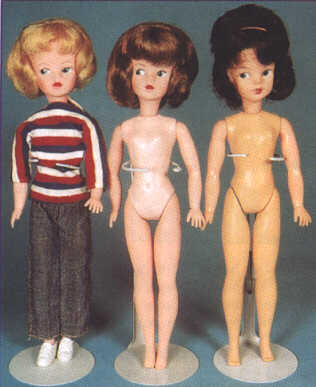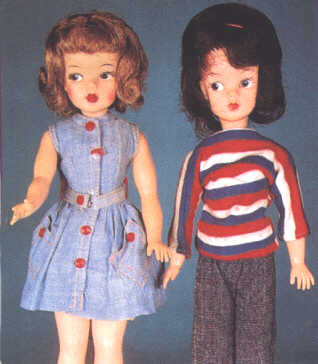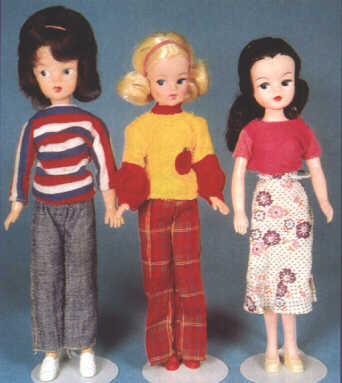
The Marx Sindy also had the separate ball neck joint of the English Active Sindy style, and the marks on their necks are the same: 2GEN1077/ 033055x. On her bottom are the words: "Made in Hong Kong."
The arrangement for Marx to sell). Sindy in the United States was unique. According to Robert McDarren, vice-president of marketting for Marx at the time (now president of The Link Group, which specializes in inventing and developing toys), the Marx venture was possible through an intercorporate agreement between Marx and Pedigree, both sister companies at that time under the conglomerate of Dunbee-Combex-Marx. McDarren had the daunting task of launching Sindy in the United States. He recalls that Sindy's outfits were thoroughly researched and that even the fabrics were changed to reflect American taste.
The basic #1000 Sindy was dressed in a tasteful dark printed cotton dress trimmed with lace. A series (#1110) of six separate outfits included a bell-bottom shopping and leisure outfit, a riding outfit and the popular ballet outfit. A special Sindy #1150, Let's Get Married, wore a styltsh bridal gown. One great advancement. by Marx was the creation of Gayle. This black doll looked exactly like Sindy except for her brown hair and eyes. She was marketed as "Sindy's friend, Gayle" and is particularly difficult to find in the ballerina outfit.
Jay Horowitz, president of Marx Toys today, recalls that, "the line included #1000, and #1001 Sindy, a black doll named Gayle per the doll's packaging, as well as numerous accessories." Catalog sheets provided by Horowitz show the vast range of Sindy's accessaries for the United states market; they included a complete dining room (with stiverware), bedroon, play room and kitchen sets.
Robert McDarren further state that Sindy #1000 and #1001 "were among the most popular dolls of all time for Marx." Today, it may take some persistence, but these Marx Sindys are among the easiest to find in the United States. Marx is clearly marked on the box, but Pedigree is not.

The Future of Sindy
Sindy is still popular today. Not many dolls can claim such a long run. Happily for Sindy fans, it appears that she will be around for a long time to come and will experience yet more exciting changes in her future. According to sources at Pedigree, they have agreed with Hasbro that Pedigree will take back responsibility for Sindy as of January 1, 1999. While Pedigree executives had made no official announcements at press time, they have indicated that they intend to re-launch Sindy with her traditional charm and classical
Carol Stover is co-author, with Judith Izen, of The Collector's Encvclopedia of Vogue Dolls, published by Collector Books.

The original Sindy made by Pedigree in 1963 and sold in Great Britain, right in photo, resembles ldeal's 1962 Tammy by Ideal, left, sold in the United States.
